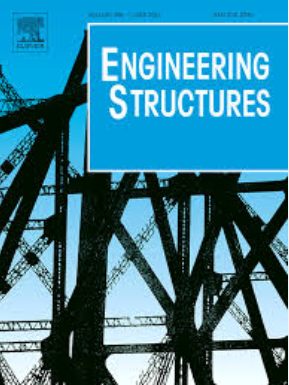Waterborne debris impact forces on wall structures: Elastic analytical model integrating the effects of the structural mass
IF 5.6
1区 工程技术
Q1 ENGINEERING, CIVIL
引用次数: 0
Abstract
To evaluate the structural safety against waterborne debris impacts, the impact loads are usually computed with analytical models such as those proposed by ASCE/SEI 7–22. These models often assume a massless structure to simplify the analytical formulations, which can be an oversimplifying and inaccurate assumption in cases where the structure is heavier and more flexible than the debris. To address this problem, we aim to define the domain in which the existing models are inaccurate and to propose a new analytical model to accurately compute the debris impact forces through comprehensive finite element simulations and analytical modelling. We defined such a domain in the design space of structure-to-debris mass and stiffness ratios and assessed which are the most accurate analytical models to compute debris impact forces across this space. Our proposed model significantly improves upon the overestimating results of the ASCE/SEI 7–22 model when both stiffness and mass are important in determining the impact forces.
求助全文
约1分钟内获得全文
求助全文
来源期刊

Engineering Structures
工程技术-工程:土木
CiteScore
10.20
自引率
14.50%
发文量
1385
审稿时长
67 days
期刊介绍:
Engineering Structures provides a forum for a broad blend of scientific and technical papers to reflect the evolving needs of the structural engineering and structural mechanics communities. Particularly welcome are contributions dealing with applications of structural engineering and mechanics principles in all areas of technology. The journal aspires to a broad and integrated coverage of the effects of dynamic loadings and of the modelling techniques whereby the structural response to these loadings may be computed.
The scope of Engineering Structures encompasses, but is not restricted to, the following areas: infrastructure engineering; earthquake engineering; structure-fluid-soil interaction; wind engineering; fire engineering; blast engineering; structural reliability/stability; life assessment/integrity; structural health monitoring; multi-hazard engineering; structural dynamics; optimization; expert systems; experimental modelling; performance-based design; multiscale analysis; value engineering.
Topics of interest include: tall buildings; innovative structures; environmentally responsive structures; bridges; stadiums; commercial and public buildings; transmission towers; television and telecommunication masts; foldable structures; cooling towers; plates and shells; suspension structures; protective structures; smart structures; nuclear reactors; dams; pressure vessels; pipelines; tunnels.
Engineering Structures also publishes review articles, short communications and discussions, book reviews, and a diary on international events related to any aspect of structural engineering.
 求助内容:
求助内容: 应助结果提醒方式:
应助结果提醒方式:


